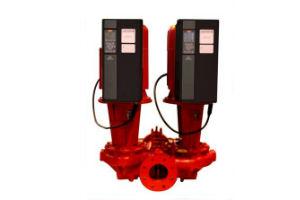 The technology of water pumps with intelligent variable speed control in three-phase motors has been working in recent years, now this concept is moving towards pumps with single-phase motors of up to 7.5 horsepower.
The technology of water pumps with intelligent variable speed control in three-phase motors has been working in recent years, now this concept is moving towards pumps with single-phase motors of up to 7.5 horsepower.
by Alfredo Sotolongo*
The most economical energy to produce is the one that is saved!
This issue of the magazine coincides with the winter ASHRAE meeting and fair to be held in the city of Orlando in Florida. I think many colleagues from all over Latin America and the Caribbean will be present. We hope that as in previous years, colleagues who participate in the ASHRAE in Orlando, as they pass through Miami back to their respective countries, will visit us to share their ideas, concerns and knowledge acquired during the fair.
Since my first visit to an ASHRAE fair in the city of Chicago at the end of the 60s, their composition has changed a lot when it comes to the manufacturers they exhibit. Even today there is a much more marked international representation than there was 46 years ago. In those years, perhaps only 10% of manufacturers came from abroad. Motivated by the rising cost of energy and environmental protection, manufacturers in America, Europe and Asia are exhibiting their products and equipment in which they demonstrate their progress in terms of energy saving and environmental protection, which is ultimately what worries our colleagues the most.
This diversity of countries and talents contribute positively to the optimal application of air conditioning systems. I just want to suggest that you get the most out of this important trade fair in our industry.
And since energy saving is my great passion, in this issue I want to take advantage of and highlight a company that exhibits at all ASHRAE fairs, Armstrong Fluid Technology. This company introduced several years ago at the fair the IVS concept that refers to water pumps with intelligent variable speed control in three-phase motors. In this next fair will be presenting for the first time to the industry the IVS concept applied to pumps with single-phase motors of up to 7.5 horsepower.
Although I have already mentioned this concept in previous issues, I am convinced that it is of the utmost importance to explain its application, benefits and what this represents for our industry. This topic is of special interest to those of us who understand that energy saving and environmental conservation are paramount to the development of our countries.
Traditionally, water pumps are selected at maximum efficiency when operating at 100% capacity. However, the behavior of most air conditioning systems reflects that they operate at 60% or less of their capacity 90% of the time. Therefore, pumps operating under the IVS concept are selected so that at 60% of their capacity they enjoy their best efficiency.
In addition, the algorithm that is integrated into the program of the variable frequency drive only allows the pump to produce what the thermal load requires at all times, neither more nor less. This results in the pump responding instantly to the system load at that time, consuming the minimum electrical energy needed to compensate for that load.
How does Armstrong achieve the most efficient operation of each pump with IVS application without the need for external sensors? In reality, the sensor is internal and does not monitor either the pressure differential or the flow rate. However, as everyone knows, when selecting a pump in the curve of the behavior of said pump the following values appear: water flow in gallons per minute, dynamic height or head represented in feet of water column, engine consumption in horsepower or kilowatts, revolutions per minute (RPM), etc...
The variable frequency drive installed on the pump next to the motor, can read the consumption of the motor and the RPM, once it locates that point of operation in the curve of the pump you can compare it with the algorithm pre programmed in the frequency inverter. Once the power consumption (KW) and revolutions per minute (RPM) are measured, it can determine the operating point in gallons per minute and the head or dynamic height in feet of water.
If it is different from what was pre programmed in the algorithm, the frequency inverter adjusts the motor to approach the design point and thus consume exactly the electrical energy required to compensate for the thermal load at all times.
To learn more about the application of the IVS concept, be sure to visit Armstrong Fluid Technologies booth #1819 at the ASHRAE show. I would love for everyone who has the opportunity to visit us at our Miami office before or after the fair. I hope to see you around here.
If you need more information on any of the topics covered in this column, please contact me at the email [email protected]
* President of Protec, Inc., is certified as a professional engineer in Puerto Rico and the state of Florida; has more than 40 years of experience in the application and sale of systems and equipment for energy conservation. He is a member of ASME (American Society of Mechanical Engineers), AEE (Association of Energy Engineers), ASHRAE and was president of the Miami chapter of that association.














